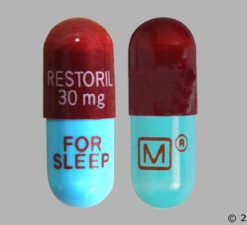Midazolam
$23.00 – $43.00
Midazolam Injection Online
Midazolam Injection Online, sold under the brand name Dormicum and Versed among others, is a benzodiazepine medication use for anesthesia and procedural sedation, and to treat severe agitation. It induces sleepiness, decreases anxiety, and causes anterograde amnesia.
The drug does not cause an individual to become unconscious, merely to be sedated. It is also useful for the treatment of prolonged (lasting over 5 minutes) seizures. Midazolam can be given by mouth, intravenously, by injection into a muscle, by spraying into the nose, or through the cheek. When given intravenously, it typically begins working within five minutes; when injected into a muscle, it can take fifteen minutes to begin working. Effects last between one and six hours.
Side effects can include a decrease in efforts to breathe, low blood pressure, and sleepiness. Tolerance to its effects and withdrawal syndrome may occur following long-term use.[11] Paradoxical effects, such as increased activity, can occur especially in children and older people. There is evidence of risk when used during pregnancy but no evidence of harm with a single dose during breastfeeding. Like other benzodiazepines, it works by increasing the activity of the GABA neurotransmitter in the brain.
Midazolam was patented in 1974 and came into medical use in 1982. It is on the World Health Organization’s List of Essential Medicines. Midazolam is available as a generic medication. In many countries, it is a controlled substance.
Medical uses
Seizures
Sometimes doctors use midazolam to manage prolonged seizures. Doctors do not recommend using it long-term for epilepsy management because it significantly increases the risk of tolerance (which makes midazolam and other benzodiazepines ineffective) and causes significant sedation. A benefit of midazolam is that doctors can administer it in the cheek or nose of children during acute seizures, including status epilepticus. Midazolam is effective for status epilepticus or situations where obtaining intravenous access is not possible. Additionally, it has advantages such as being water-soluble, having a rapid onset of action, and not causing metabolic acidosis from the propylene glycol vehicle (which is unnecessary due to its solubility in water), a side effect associated with other benzodiazepines.
Drawbacks include a high degree of breakthrough seizures—due to the short half-life of midazolam—in over 50% of people treated, as well as treatment failure in 14–18% of people with refractory status epilepticus. Rapid tolerance develops to the anticonvulsant effect, requiring increasing the dose several times to maintain therapeutic anticonvulsant effects. With prolonged use, tolerance and tachyphylaxis can occur and the elimination half-life may increase, up to days. Buccal and intranasal midazolam may be both easier to administer and more effective than rectally administered diazepam in the emergency control of seizures.
Procedural sedation
Intravenous midazolam is indicated for procedural sedation (often in combination with an opioid, such as fentanyl), preoperative sedation, for the induction of general anesthesia, and for sedation of people who are ventilated in critical care units. Midazolam is superior to diazepam in impairing memory of endoscopy procedures, but propofol has a quicker recovery time and a better memory-impairing effect. It is the most popular benzodiazepine in the intensive care unit (ICU) because of its short elimination half-life, combined with its water solubility and its suitability for continuous infusion.
However, healthcare providers prefer lorazepam for long-term sedation because of its long duration of action, and propofol outperforms midazolam in the ICU for sedation by reducing weaning time and facilitating earlier tracheal extubation.
Neonatal intensive care units occasionally employ midazolam, requiring healthcare providers to exercise extra caution.
caution in newborns; they should not administer midazolam for longer than 72 hours due to the risks of tachyphylaxis and the potential development of a benzodiazepine withdrawal syndrome, as well as neurological complications. Healthcare providers should avoid bolus injections due to the heightened risk of cardiovascular depression and neurological complications. Sometimes, doctors use midazolam in newborns who need mechanical ventilation, but they prefer morphine for this purpose because it has a better safety profile.
| Quantity | 5 ML/25 mg, 10 ML/50 mg |
|---|
Reviews
There are no reviews yet.
Related products
Benzodiazepines (Anti Depressant and Anxiety Medications)
Benzodiazepines (Anti Depressant and Anxiety Medications)
Opiates And Opioid (Painkillers)
Benzodiazepines (Anti Depressant and Anxiety Medications)
Benzodiazepines (Anti Depressant and Anxiety Medications)
Anabolic Steroids
Benzodiazepines (Anti Depressant and Anxiety Medications)
Benzodiazepines (Anti Depressant and Anxiety Medications)












Be the first to review “Midazolam”